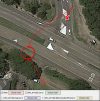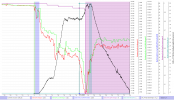It's easy to see what & why this happened ...
You started out this flight with 60% battery ... did you drain the first 40% on a flight just before this or had this battery been laying around on 60% for a while before this day?
Already before you crossed that road only 37sec after take off your battery was down to really critical levels with one cell down to just a tad above 3v ... with a total battery voltage on 12,7v. The Lowcellvoltage threshold was defined to 12v for the total battery. Here below, circled in red, your battery was rendered "NotSafe" by the firmware.
View attachment 137979
Here below all relevant data for this incident are depicted in a chart ...
The green/blue background area to the left is motor start & take off
The pink background area to the right is Lowbattery force landing
The purple graph is the battery percentage
The red graph is the total battery voltage (full is usually slightly above 16,8v... & 0% around 14v)
The green graph is the lowest cell voltage of the 4 cells in the battery
The blue is the low voltage threshold
The darker green graph is an indication regarding battery safety ... 0=safe 1=not safe
The black graph is the relative height from your HP
(Click on the chart to make it larger ... values in the bottom legend is from where the chart marker is placed in the chart)
View attachment 137980
Pretty straight forward ... just after take off at least one cell in your battery fails & drops quickly down to dangerous voltage levels. When the total battery voltage goes below the threshold of 12v the firmware marks the voltage level not safe & initiate a lowbattery force landing ... end of story.
That the battery percentage started out on 60% & then suddenly dropped to zero comes from that the BMS (battery management system) realize that it's initial calculation of 60% was wrong... & gives up and show 0% instead. Most probably this battery was heavily unbalanced cell voltage wise ... showing a total voltage that correlated to 60% in the beginning. Then when you took off the BMS monitored the mah consumption & counted down the percentage ... until the total battery voltage dropped like a rock & the BMS realize that the percentage calculation was totally wrong.
The root cause to this lies in either of 2 factors ...
Either this battery had a manufacturing fault already from start ... with one cell in the battery always showing significant worse performance than the other 3...
... or it's due to how you have used, stored & taken care of the battery during those 65 charge cycles ... it's not difficult to kill a battery during 65 cycles if you abuse it.
Below you have some important points regarding the batteries that keep our drones airborne ...
- Keeping the battery at 100% isn't good for it ... do what you can to minimize the time that they are at that level, the default up to 10 days auto discharge down to 60-65% is way too long ... & if you check the level by pushing the button you reset the counter & the 10 day counter will restart. If a battery that is above storage % level haven't been used in a couple days, use the USB adapter from the Fly More Kit to charge something else (your phone) in order to bring it down to storage % (see below ...)
- Heat kills them ... don't store above room temperature & absolutely not in a car during summer, a couple hours in a burning hot car & the battery have sustained serious damage.
- Let them cool down to room temperature before recharging them.
- Don't fly with a battery colder than 15C degrees, keep them warm in colder weather, have them in a pocket close to your body.
- Store the batteries between 40-60% ... a good thumb rule is to take them of the charger as soon as the third led start to blink, then they are just over 50%. But anything between 1 solid + 1 blinking up to 2 solid + 1 blinking is good enough.
- Don't drain them to low, make sure they don't go under 15% ... once in a while, so be it. Set the ambition to not have them lower than 20% ... if you aim for that you usually don't end up below 15%.
- Don't fly with a battery not recently fully charged, having a battery laying around partially charged for a longer period may make the cells in the battery unbalanced, using a unbalanced battery can make that lower cell fail soon after take off, & initiate a forced low battery auto landing you can’t stop.
- If stored for a long time, cycle them at least once each third month ... then back to storage %.
First of all ... batteries will not last forever
...they will either slowly degrade until the point where the useful flight times are so short that you stop using it
...or it will have a sudden cell failure which will trigger a sudden forced auto landing in the worst possible place
...or it will slowly start to swell to the point where they not fit into the drone anymore
...or the swelling goes off instantly or gets worse when the battery gets hot & push itself out of the drone at height.
The only visual sign is swelling ... which not always occur. Furthermore different drone models have different possibilities to handle a smaller momentary swelling when hot during flight.
So a battery can't be judged only by that it take charge to 100%, isn't swollen & manage to power your drone without mishaps ... too much is going on hidden from just a visual inspection or a test flight, you may have been on the verge to a disaster without knowing it.
You have mainly 2 methods to both prolong the useful service life of the battery & prevent sudden failures ... & judge when it's time to either limit the flight duty (in colder temps for instance) or completely take it off flight tasks.
1.Battery Care
...Never keep the battery cell voltage outside 3,7-3,8v for a longer period than 48h (that is a battery charged to approx 50%). If too high after a flight, discharge them, too low charge them up to storage level again.
...Store them in room temperature ... (too warm is more damaging than too cold)
...Never let them overheat ... (left in the sun or thrown in a hot car)
...Don't charge them hot, let them cool down to room temperature
...Don't use cold batteries, try to have them at room temperature before using them
...Respect the operational ambient temperature specified in the user manual
...Don't push the battery for amp draw (both sticks on max inputs at the same time in Sport mode) when cold or hot ambient temps
...Don't fly them below 15% other in exceptional cases
...Always start a day of flying with the batteries freshly fully charged
2.Battery performance follow up over time
...Follow how the useful calculated max flight time change
...Compare the full charged max mAh compared to the designed mAh
...Monitor how the cell deviations degrades
For all points regarding the battery performance it's a question about
trends over time ... just looking at a single flight will not give any insight over the actual health ... having a bit shorter flight time or some bigger cell deviations in one flight can be normal if using Sport mode or flying in colder ambient temps for instance. The paid Airdata subscriptions give the possibility to check these trends over all flight logs uploaded there ... it gives a good decision base to understand the battery health & if it's time to take it off duty.
















